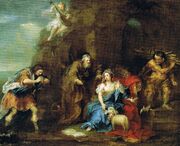No edit summary |
No edit summary |
||
| Line 2: | Line 2: | ||
There is no obvious single source for the plot of ''The Tempest'', but researchers have seen parallels in Erasmus' ''Naufragium'', Peter Martyr's ''De orbe novo'', and eyewitness reports by William Strachey and Sylvester Jordain of the real-life shipwreck of the ''Sea Venture'' on the islands of [[Bermuda]], and the subsequent conflict between Sir Thomas Gates and Sir George Somers. In addition, one of Gonzalo's speeches is derived from Montaigne's essay "Of the Canibales," and much of Prospero's renunciative speech is taken word for word from a speech by Medea in Ovid's poem ''Metamorphoses''. The masque in Act 4 may have been a later addition, possibly in honour of the wedding of Princess Elizabeth and Frederick V in 1613. The play was first published in the First Folio of 1623. |
There is no obvious single source for the plot of ''The Tempest'', but researchers have seen parallels in Erasmus' ''Naufragium'', Peter Martyr's ''De orbe novo'', and eyewitness reports by William Strachey and Sylvester Jordain of the real-life shipwreck of the ''Sea Venture'' on the islands of [[Bermuda]], and the subsequent conflict between Sir Thomas Gates and Sir George Somers. In addition, one of Gonzalo's speeches is derived from Montaigne's essay "Of the Canibales," and much of Prospero's renunciative speech is taken word for word from a speech by Medea in Ovid's poem ''Metamorphoses''. The masque in Act 4 may have been a later addition, possibly in honour of the wedding of Princess Elizabeth and Frederick V in 1613. The play was first published in the First Folio of 1623. |
||
| + | |||
| + | ==Literary comment== |
||
| + | Scattered incidental references to ''The Tempest'' can be found at [[Shakespearean References in Turtledove's Work]]. |
||
==The Tempest in [[State of Jefferson Stories|State of Jefferson]]== |
==The Tempest in [[State of Jefferson Stories|State of Jefferson]]== |
||
| Line 9: | Line 12: | ||
==The Tempest in "[[We Haven't Got There Yet]]"== |
==The Tempest in "[[We Haven't Got There Yet]]"== |
||
In 1606, a time-displaced 21st-century actress name [[Jessica (We Haven't Got There Yet)|Jessica]] met [[William Shakespeare (We Haven't Got There Yet)|William Shakespeare]], and quoted lines from '''''The Tempest''''', which he would not write until 1610 or 1611, at least in her [[oTL|original timeline]]. The implications of this alarmed Shakespeare to the point that he fled the [[The Rose (We Haven't Got There Yet)|theatre]]. |
In 1606, a time-displaced 21st-century actress name [[Jessica (We Haven't Got There Yet)|Jessica]] met [[William Shakespeare (We Haven't Got There Yet)|William Shakespeare]], and quoted lines from '''''The Tempest''''', which he would not write until 1610 or 1611, at least in her [[oTL|original timeline]]. The implications of this alarmed Shakespeare to the point that he fled the [[The Rose (We Haven't Got There Yet)|theatre]]. |
||
| + | |||
| ⚫ | |||
| + | {{State of Jefferson}} |
||
| ⚫ | |||
[[Category:Plays of Shakespeare]] |
[[Category:Plays of Shakespeare]] |
||
[[Category:Inconsistencies]] |
[[Category:Inconsistencies]] |
||
Revision as of 18:29, 2 June 2020

Scene from The Tempest, painted by William Hogarth in 1735. Left to right: Ferdinand, Ariel (flying), Prospero, Miranda, and Caliban.
The Tempest is a play by William Shakespeare, believed to have been written in 1610 or 1611, and thought by many critics to be the last play that Shakespeare wrote alone. (He wrote a few later plays together with John Fletcher.) It is set on a remote island, where the sorcerer Prospero, rightful Duke of Milan, plots to restore his daughter Miranda to her rightful place using illusion and skillful manipulation. He conjures up a storm, the eponymous tempest, to lure his usurping brother Antonio and the complicit King Alonso of Naples to the island. There, his machinations bring about the revelation of Antonio's lowly nature, the redemption of the King, and the marriage of Miranda to Alonso's son, Ferdinand.
There is no obvious single source for the plot of The Tempest, but researchers have seen parallels in Erasmus' Naufragium, Peter Martyr's De orbe novo, and eyewitness reports by William Strachey and Sylvester Jordain of the real-life shipwreck of the Sea Venture on the islands of Bermuda, and the subsequent conflict between Sir Thomas Gates and Sir George Somers. In addition, one of Gonzalo's speeches is derived from Montaigne's essay "Of the Canibales," and much of Prospero's renunciative speech is taken word for word from a speech by Medea in Ovid's poem Metamorphoses. The masque in Act 4 may have been a later addition, possibly in honour of the wedding of Princess Elizabeth and Frederick V in 1613. The play was first published in the First Folio of 1623.
Literary comment
Scattered incidental references to The Tempest can be found at Shakespearean References in Turtledove's Work.
The Tempest in State of Jefferson
In 1980, the Ashland Shakespeare Festival was preparing a performance of The Tempest.
The Tempest in "We Haven't Got There Yet"
In 1606, a time-displaced 21st-century actress name Jessica met William Shakespeare, and quoted lines from The Tempest, which he would not write until 1610 or 1611, at least in her original timeline. The implications of this alarmed Shakespeare to the point that he fled the theatre.
| ||||||||||||||
| ||||||||||
